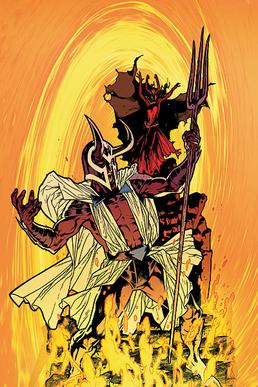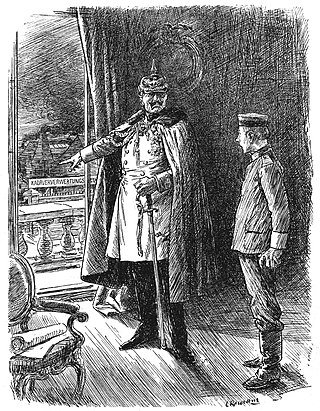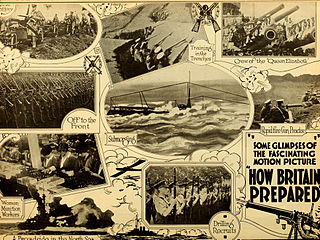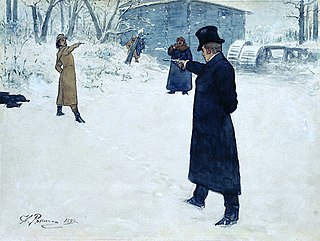Related Research Articles

Carl Philipp Gottfriedvon Clausewitz was a Prussian general and military theorist who stressed the "moral" and political aspects of waging war. His most notable work, Vom Kriege, though unfinished at his death, is considered a seminal treatise on military strategy and science.

A demon is a malevolent supernatural entity. Historically, belief in demons, or stories about demons, occurs in folklore, mythology, religion, and literature; these beliefs are reflected in media including comics, fiction, film, television, and video games. Belief in demons probably goes back to the Paleolithic age, stemming from humanity's fear of the unknown, the strange and the horrific. In ancient Near Eastern religions and in the Abrahamic religions, including early Judaism and ancient-medieval Christian demonology, a demon is considered a harmful spiritual entity that may cause demonic possession, calling for an exorcism. Large portions of Jewish demonology, a key influence on Christianity and Islam, originated from a later form of Zoroastrianism, and was transferred to Judaism during the Persian era.

Vom Kriege is a book on war and military strategy by Prussian general Carl von Clausewitz (1780–1831), written mostly after the Napoleonic wars, between 1816 and 1830, and published posthumously by his wife Marie von Brühl in 1832. It is one of the most important treatises on political-military analysis and strategy ever written, and remains both controversial and influential on military strategic thinking.

Propaganda is communication that is primarily used to influence or persuade an audience to further an agenda, which may not be objective and may be selectively presenting facts to encourage a particular synthesis or perception, or using loaded language to produce an emotional rather than a rational response to the information that is being presented. Propaganda can be found in a wide variety of different contexts.
Demonization or demonisation is the reinterpretation of polytheistic deities as evil, lying demons by other religions, generally by the monotheistic and henotheistic ones. The term has since been expanded to refer to any characterization of individuals, groups, or political bodies as evil.

Dehumanization is the denial of full humanity in others along with the cruelty and suffering that accompany it. A practical definition refers to it as the viewing and the treatment of other people as though they lack the mental capacities that are commonly attributed to humans. In this definition, every act or thought that regards a person as "less than" human is dehumanization.

Blaze and Satanus are twin fictional demonic siblings appearing in American comic books published by DC Comics. Blaze debuted in Action Comics #655, created by Roger Stern and Brett Breeding and first pencilled by Bob McLeod. Later, Satanus was created by Brett Breeding and debuted in The Adventures of Superman #493 by Jerry Ordway and Tom Grummett. The twin duo originally starred as Superman villains associated with the supernatural but were later revealed to be the children of the Wizard Shazam, Blaze respectively depicted as a powerful enemy of the Marvel Family.

Propaganda was a crucial tool of the German Nazi Party from its earliest days in 1920, after its reformation from the German Worker’s Party (DAP), to its final weeks leading to Germany's surrender in May 1945. As the party gained power, the scope and efficacy of its propaganda grew and permeated an increasing amount of space in Germany and, eventually, beyond.
The Grand Anti-Masonic Exhibition was the name of an antisemitic exhibition that was opened on October 22, 1941 during World War II in Belgrade, the capital of the Nazi Germany-established Militärverwaltung in occupied Serbia.

Propaganda in the Soviet Union was the practice of state-directed communication aimed at promoting class conflict, proletarian internationalism, the goals of the Communist Party of the Soviet Union, and the party itself.

Ethnic hatred, inter-ethnic hatred, racial hatred, or ethnic tension refers to notions and acts of prejudice and hostility towards an ethnic group to varying degrees.

The German Corpse Factory or Kadaververwertungsanstalt, also sometimes called the "German Corpse-Rendering Works" or "Tallow Factory" was one of the most notorious anti-German atrocity propaganda stories circulated in World War I. In the postwar years, investigations in Britain and France revealed that these stories were false.
During the Yugoslav Wars (1991–2001), propaganda was widely used in the media of the Federal Republic of Yugoslavia, and of Croatia and Bosnia.

In the First World War, British propaganda took various forms, including pictures, literature and film. Britain also placed significant emphasis on atrocity propaganda as a way of mobilising public opinion against Imperial Germany and the Central Powers during the First World War. For the global picture, see Propaganda in World War I.

An enemy or a foe is an individual or a group that is considered as forcefully adverse or threatening. The concept of an enemy has been observed to be "basic for both individuals and communities". The term "enemy" serves the social function of designating a particular entity as a threat, thereby invoking an intense emotional response to that entity. The state of being or having an enemy is enmity, foehood or foeship.
Atrocity propaganda is the spreading of information about the crimes committed by an enemy, which can be factual, but often includes or features deliberate fabrications or exaggerations. This can involve photographs, videos, illustrations, interviews, and other forms of information presentation or reporting.

World War I was the first war in which mass media and propaganda played a significant role in keeping the people at home informed on what occurred at the battlefields. It was also the first war in which governments systematically produced propaganda as a way to target the public and alter their opinion.
The public image of Slobodan Milošević, concerns the image of Slobodan Milošević, the former president of Serbia and FR Yugoslavia among the residents of former Yugoslavia and worldwide. Before the Yugoslav Wars the public image of Slobodan Milošević oscillated from faceless bureaucrat to defender of Serbs. During the Yugoslav Wars his image again oscillated from Balkan Butcher to Guarantor of Peace and back.
The basic principles of war propaganda (Principes élémentaires de propagande de guerre) is a monograph by Anne Morelli published in 2001. It has not been translated into English. The subtitle recommends its "usability in case of cold, hot or lukewarm war".

Incitement to genocide is a crime under international law which prohibits inciting (encouraging) the commission of genocide. An extreme form of hate speech, incitement to genocide is an inchoate offense and is theoretically subject to prosecution even if genocide does not occur, although charges have never been brought in an international court without mass violence having occurred. "Direct and public incitement to commit genocide" was forbidden by the Genocide Convention in 1948. Incitement to genocide is often cloaked in metaphor and euphemism and may take many forms beyond direct advocacy, including dehumanization and accusation in a mirror.
References
- ↑ Dower, Nigel (7 July 2009). The Ethics of War and Peace. Polity. p. 91. ISBN 978-0-7456-4168-3.
...the demonization or dehumanization of the enemy...
- ↑ Danielle Rowell (October 2011). The Power of Ideas: A Political Social-Psychological Theory of Democracy, Political Development and Political Communication. Universal-Publishers. p. 162. ISBN 978-1-61233-769-2.
State propaganda models are tactical strategies that employ enemy demonization techniques. The state promotes the idea that the threat (that is, tangible or intangible) is an evil aggressor whose sole goal is the destruction of the status quo.
- ↑ Conserva, Henry T. (1 February 2003). Propaganda Techniques. AuthorHouse. p. 3. ISBN 978-1-4107-0496-2.
The oldest trick of the propagandist is to demonize and dehumanize the hated other or others and make the enemy a ...
- ↑ Jules Boykoff (2007). Beyond bullets: the suppression of dissent in the United States. AK Press. p. 192. ISBN 978-1-904859-59-8.
- ↑ Jonathan J. Price (19 July 2001). Thucydides and Internal War. Cambridge University Press. p. 127. ISBN 978-1-139-42843-9 . Retrieved 29 August 2013.
It is a banal fact that political leaders of nations fighting wars habitually demonize the enemy.... Hellenic speakers who strive to demonize and conceptually alienate other Hellenes....
- ↑ Steve Thorne (12 April 2006). The Language of War . Routledge. p. 93. ISBN 978-0-203-00659-7 . Retrieved 6 December 2013.
In an article published in The Guardian (4 October 2001), Philip Knightley points out: The way wars are reported in the western media follows a depressingly predictable pattern: stage one, the crisis; stage two, the demonisation of the enemy's leader, stage three, the demonization of enemy as individuals; and stage four, atrocities.
- ↑ Scott, Ian (1 January 2006). In Capra's Shadow: The Life and Career of Screenwriter Robert Riskin. University Press of Kentucky. p. 169. ISBN 0-8131-7135-0 . Retrieved 24 December 2013.
They included scenes of enemy demonization and flag-waving patriotism, much in the vein of documentaries being prepared within the State Department and other bodies.
- ↑ Heretz, Leonid (28 February 2008). Russia on the Eve of Modernity: Popular Religion and Traditional Culture under the Last Tsars. Cambridge University Press. p. 204. ISBN 978-1-139-47066-7.
- ↑ Machiavelli, Niccolo (28 November 2013). "26. Scorn and Abuse arouse Hatred against those who indulge in them without bringing them any Advantage". In Crick, Bernard (ed.). The Discourses. Penguin UK. p. 347. ISBN 978-0-14-191318-6.
- ↑ George Kassimeris; John Buckley (28 March 2013). The Ashgate Research Companion to Modern Warfare. Ashgate Publishing, Ltd. p. 284. ISBN 978-1-4094-9953-4 . Retrieved 29 August 2013.
When official doctrine and guidance demonize the enemy and play on soldiers' fears, atrocities become inevitable'. ... As Carl von Clausewitz noted in On War, when either side in a conflict adopts such a strategy, demonization inevitably followed by atrocities... and thus the vicious cycle of savage war endlessly repeats until one side ultimately prevails.
- ↑ Hall Gardner (2005). American Global Strategy and the 'war on Terrorism'. Ashgate Publishing, Ltd. p. 16. ISBN 978-1-4094-9589-5 . Retrieved 29 August 2013.
- ↑ Michael Bhatia (18 October 2013). Terrorism and the Politics of Naming. Routledge. p. 150. ISBN 978-1-317-96986-0 . Retrieved 6 December 2013.
Demonisation... In other words, portraying the enemy as malicious and repulsive creates feelings that makes killings easier.
- ↑ C. A. J. Coady (8 October 2007). Morality and Political Violence. Cambridge University Press. p. 274. ISBN 978-1-139-46527-4 . Retrieved November 11, 2019.
The tendency to portray one's enemy as so evil as to be demonic has several bad effects. One is that of treating the whole enemy population - or, less drastically, the whole of the enemy civil and political apparatus - as tainted with the same satanic brush as the leadership itself.
- ↑ "Quotations from Mao Tse Tung — Chapter 2".